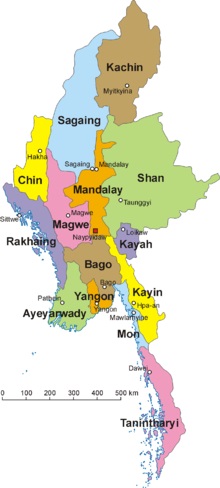![]()
| National flag of Myanmar |  |
Yellow: solidarity Green: peace Red: value and decisiveness Star: "the continued existence of the union consolidated" |
||
| Map of Myanmar / Burma | ||||
 |
||||
| Total area | 678,500 km² (2,000 km from north to south and 960 km from East to West) | |||
| Capital | Naypyidaw | |||
| Population | 51 418 420 citizens | |||
| Average salary | 75 euros/month | |||
| Borders | Thailand, Laos, China, Bangladesh et India | |||
| Official language | Burmese | |||
| Languages | More than 200 dialects | |||
| Religion (official numbers) | Buddhist 89%, Christians 4%, Muslims 4%, Animistic 1%, others 2% | |||
| A brief history | Myanmar became a province of Bristish India in 1886, then a colony with its capital Rangoon (Yangoon today) until January 4, 1948, the Independance Day. The military dictatorship was established in 1962 and ended in 2011 following the release of Aung San Suu Kyi, a burmese parliament member today. | |||
| Visa | It is imperative to obtain a visa before entering Myanmar. Please contact Burma embassy in your country to obtain a valid visa. | |||
| Recommended vaccines before departure | Universal vaccines (diphteria, tetanus, pertussis, polio, hepatitis B, hepatitis A, typhoid). For stays in rural areas longer than 48 hours, the vaccine against rabies is recommended. | |||
| Malaria | Country groupe 3: Preventive treatment with mefloquine necessary, consult your doctor before your departure. | |||
| Local time | GMT + 6 | |||
| Local currency | Kyat | |||
| Exchange | At banks and official exchange offices. Bring large denomination banknotes; new or in excellent condition. | |||
| Driving | Right side | |||
| Climate | June-September: monsoon | |||
| November-January: dry season, warm weather | ||||
| February-May: hot season | ||||
| Don'ts | In line with other countries in Southeast Asia, removing shoes is mandatory before entering a temple, a house, and sometimes, even a store. It is considered extremely rude to show the soles of the foot in front of a representation of Buddha. Generally speaking, toes should not be directed to an individual. Women should keep a certain distance from Buddhist monks and wear a dress (covered shoulders and legs to the knees) in places of worship. One must refrain from touching the head of a person, even the children! This can be considered rude. Emotional demonstrations are rare in public. | |||
| Local food | Burmese cuisine has been highly influenced by Indian, Chinese, and Thai cuisines. It is characterized by its moderate spicy taste. A traditional meal consists of curry, steam rice, fermented sauce or dried fish and vegetables. | |||
| Basic vocabulary | ||||
| Hello | Mingalaba | |||
| Goodbye | dada | |||
| How are you? | né kaon de la | |||
| What is your name? | thin kyun note ko thin nan me pyaw naing ba tha lar | |||
| My name is | tcheno (male) / tchema (female)…lo kho ba dé | |||
| I'm pleased to meet you | twé'ya da woun tha ba dè | |||
| I don't understand | nga na lè ba di | |||
| I'm english | tcheno ( masculin)/ tchema pynti lou myô ba | |||
| Thank you | tje zu tin ba dé | |||
| You're welcome | ya ba dé | |||
| Yes | houkè | |||
| No | mehou pa bou | |||
| Where is the bathroom/toilets? | einda bé ma lé? | |||
| How much? | be laon lé? | |||
| Sorry, excuse me | sé mashi ba né thi khan ba | |||
| How much is this? | da bè lao lè, dhar ka be laut le | |||
| It's very expensive | dhar ka a yan zay kyi de | |||
| It's too expensive | zémiadé | |||
| This is very good / beautiful | la ba dè | |||
| Give me this / that | da / ho ha'pè ba | |||
| Yesterday | ma nei ka | |||
| Today | dnei | |||
| Tomorrow | ma nat pan | |||
| One | tit | |||
| Two | hni | |||
| Three | thôn | |||
| Four | lè | |||
| Five | ngâ | |||
| Six | chauk | |||
| Seven | khun | |||
| Eight | chit | |||
| Nine | ko | |||
| Ten | taze | |||
| Twenty | hni ze | |||
| Hundred | ta ya | |||
| Thousand | ta taung | |||
![]()
![]()
| Tweet | S/Y Aventure |  |
 |
![]()


